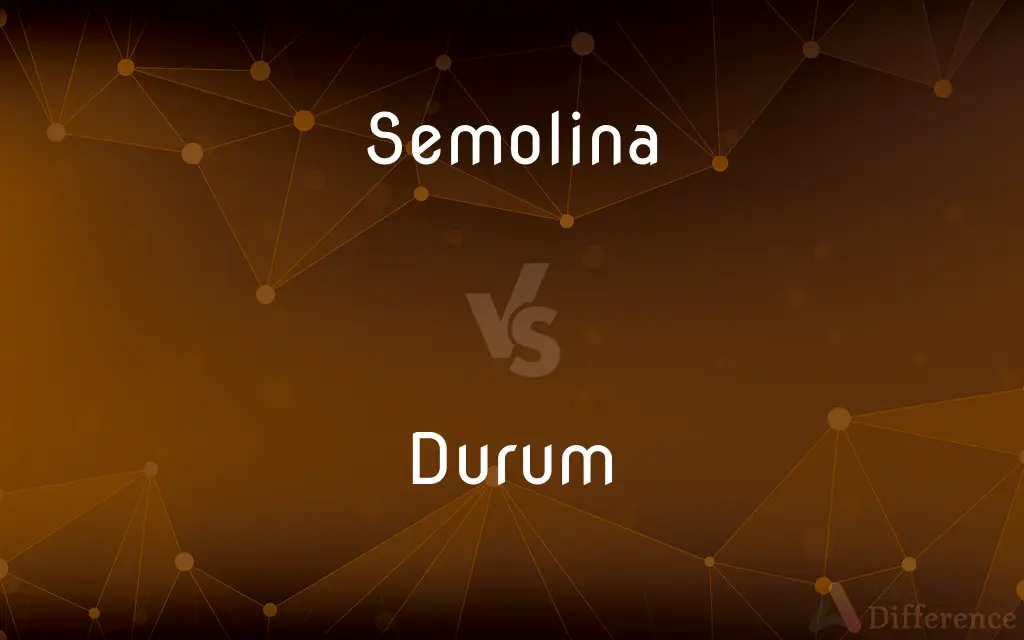Semolina vs. Durum — What's the Difference?
By Tayyaba Rehman — Updated on October 26, 2023
Semolina is a coarse flour made from durum wheat. Durum is a hard species of wheat used to produce semolina.

Difference Between Semolina and Durum
Table of Contents
ADVERTISEMENT
Key Differences
Semolina and Durum are terms often used interchangeably, but they signify different things. Semolina is the gritty, coarse flour derived from the heart of the durum wheat kernel. Durum, on the other hand, refers to the specific type of hard wheat from which semolina is made.
Semolina boasts a yellowish hue and is known for its robust, earthy taste. It is commonly used in making pastas, breads, and some desserts. Durum, the wheat itself, is renowned for its high protein content and hard texture, making it the preferred wheat for certain food products.
The extraction of semolina involves milling the durum wheat. During this milling process, the endosperm of the durum wheat is ground into semolina. Thus, while durum pertains to the wheat grain, semolina pertains to a particular grind of that grain.
It's crucial to recognize that not all flour made from durum wheat is semolina. Semolina is a specific coarseness of durum flour. So, while all semolina comes from durum wheat, not all durum wheat is ground into semolina.
Comparison Chart
Definition
Coarse flour from durum wheat.
A hard species of wheat.
ADVERTISEMENT
Usage
Making pasta, bread, and desserts.
Ground to produce semolina and other flours.
Texture
Gritty and coarse.
Hard grain.
Color
Yellowish hue.
Amber-colored grain.
Relation
Derived product.
Source grain.
Compare with Definitions
Semolina
A primary ingredient in various Mediterranean and Middle Eastern dishes.
Couscous, a popular dish, is made from semolina.
Durum
A hard species of wheat.
Durum wheat is renowned for its protein content.
Semolina
The gritty, granular byproduct of durum wheat milling.
The semolina gave the bread a slightly textured feel.
Durum
Known for its resilience in dry conditions.
Farmers prefer durum in arid regions because of its hardiness.
Semolina
A coarse flour made from durum wheat.
I used semolina to make homemade pasta.
Durum
The primary wheat used to produce semolina flour.
The best pasta is often made from durum wheat.
Semolina
Often used for its ability to provide structure in baking.
For a firm crust, I added some semolina to the dough.
Durum
Recognized for its amber-colored kernels.
The durum grains stood out in the field due to their distinct color.
Semolina
Known for its yellowish hue and distinct taste.
The semolina pudding had a rich, golden color.
Durum
Contains a high gluten and protein content.
Bakers often blend durum with other grains to balance the gluten content.
Semolina
Semolina is the coarse, purified wheat middlings (intermediate milling stage) of durum wheat mainly used in making couscous, pasta, and sweet puddings. The term semolina is also used to designate coarse middlings from other varieties of wheat, and sometimes other grains (such as rice or corn) as well.
Durum
Durum wheat (), also called pasta wheat or macaroni wheat (Triticum durum or Triticum turgidum subsp. durum), is a tetraploid species of wheat.
Semolina
The coarser particles produced by milling durum wheat, used especially for making pastas and hot cereals.
Durum
A type of wheat (Triticum turgidum subsp. durum syn. T. durum) having hard grains with high protein and gluten content, thought to have been developed in the Middle East in the Neolithic period and now used chiefly in making pasta.
Semolina
Coarse grains produced at an intermediate stage of wheat flour milling.
Durum
Ellipsis of durum wheat
Durum pasta
Durum bread
Semolina
Such grains, usually from durum wheat, used in the preparation of pasta, couscous and various sweet dishes.
Durum
Wheat with hard dark-colored kernels high in gluten and used for bread and pasta; grown especially in southern Russia, North Africa, and northern central North America
Semolina
(culinary) semolina pudding
Semolina
The purified fine, hard parts of durum wheat, derived mostly from the endosperm, rounded by the attrition of the millstones, - used in cookery, such as in the preparation of Italian pasta.
Semolina
Milled product of durum wheat (or other hard wheat) used in pasta
Common Curiosities
What gives Semolina its yellowish hue?
Semolina's yellowish hue comes from the natural color of the durum wheat endosperm.
Is all pasta made from Durum?
While many high-quality pastas are made from durum, not all pastas use it as the primary ingredient.
Is Semolina gluten-free?
No, since Semolina is derived from durum wheat, it contains gluten.
Is Durum a type of wheat?
Yes, Durum is a hard species of wheat.
What is the difference between Durum flour and Semolina?
Durum flour is finely ground, while Semolina is coarser, both derived from durum wheat.
Can I replace regular flour with Semolina in recipes?
Semolina can be used in recipes, but it may alter the texture and flavor, so adjustments might be needed.
Can Semolina be used for baking?
Yes, Semolina can be used in baking for a textured feel and firm structure.
Is Durum the hardest type of wheat?
Yes, Durum is considered the hardest type of wheat due to its high protein content.
What is Semolina commonly used for?
Semolina is commonly used for making pasta, bread, and some desserts.
Is Semolina good for health?
Semolina is rich in protein, fiber, and B vitamins, making it nutritious when consumed in moderation.
Why does pasta made from Semolina have a distinct taste?
Semolina, derived from durum wheat, imparts a robust, earthy taste to the pasta.
How is Durum wheat different from common wheat?
Durum is harder, has a higher protein content, and is primarily used for semolina, unlike common wheat.
Why is Durum preferred for certain food products?
Durum's high protein content and hard texture make it ideal for products like pasta.
Can people with gluten intolerance eat Semolina?
No, since Semolina contains gluten, it's not suitable for those with gluten intolerance.
Where is Durum wheat primarily grown?
Durum wheat is primarily grown in regions like the Mediterranean, North America, and parts of Asia.
Share Your Discovery

Previous Comparison
Bowl vs. Plate
Next Comparison
Honey vs. VinegarAuthor Spotlight
Written by
Tayyaba RehmanTayyaba Rehman is a distinguished writer, currently serving as a primary contributor to askdifference.com. As a researcher in semantics and etymology, Tayyaba's passion for the complexity of languages and their distinctions has found a perfect home on the platform. Tayyaba delves into the intricacies of language, distinguishing between commonly confused words and phrases, thereby providing clarity for readers worldwide.














































